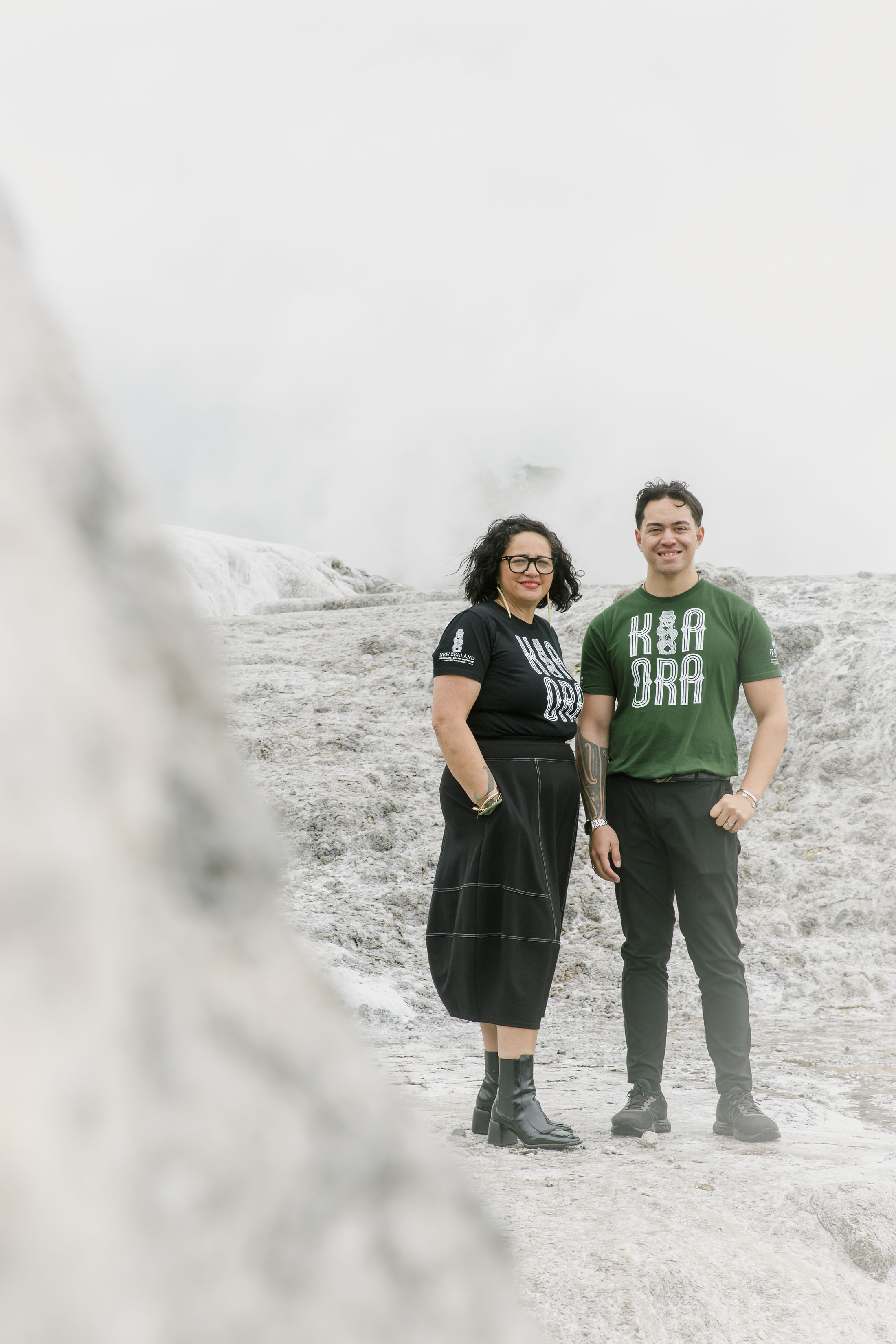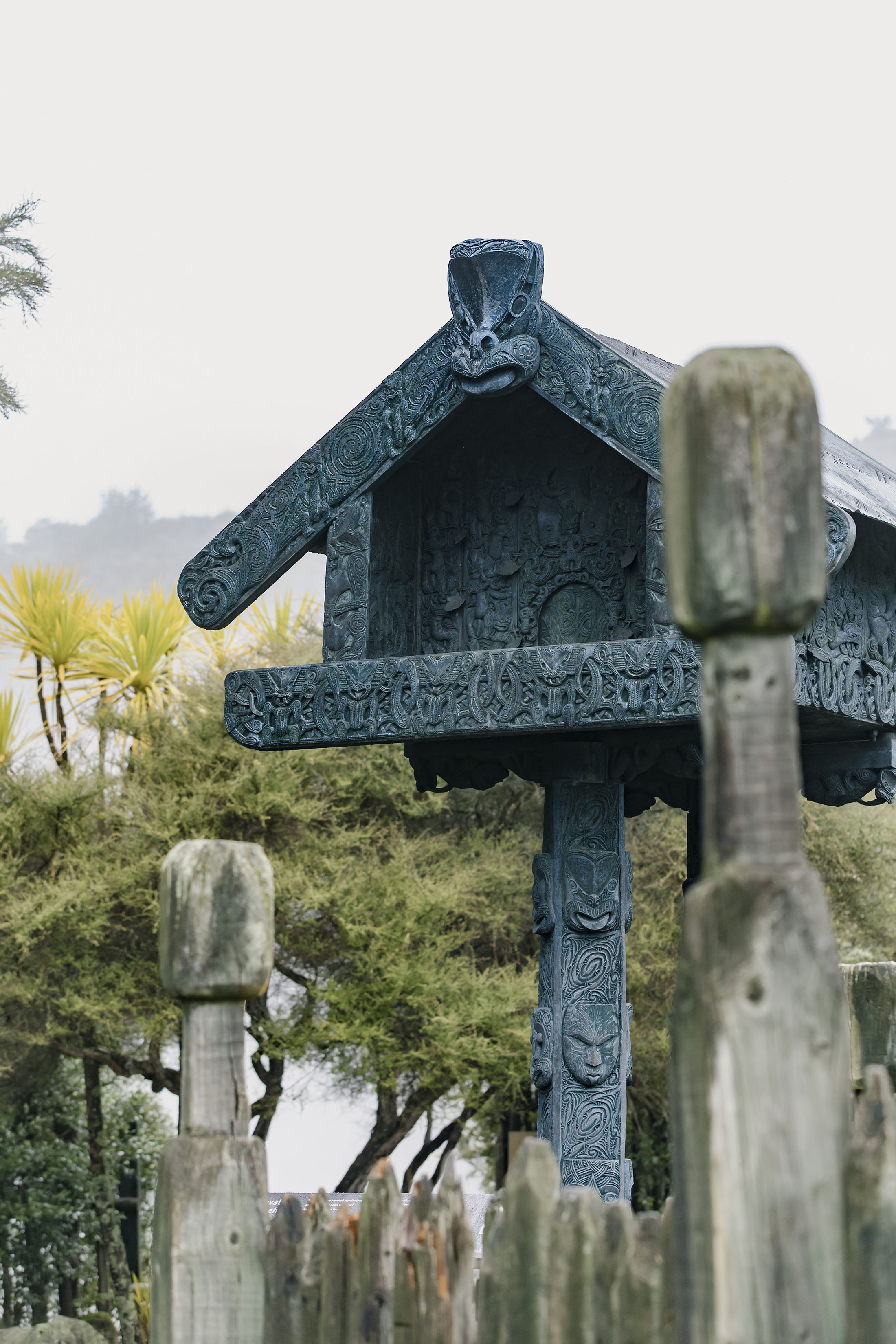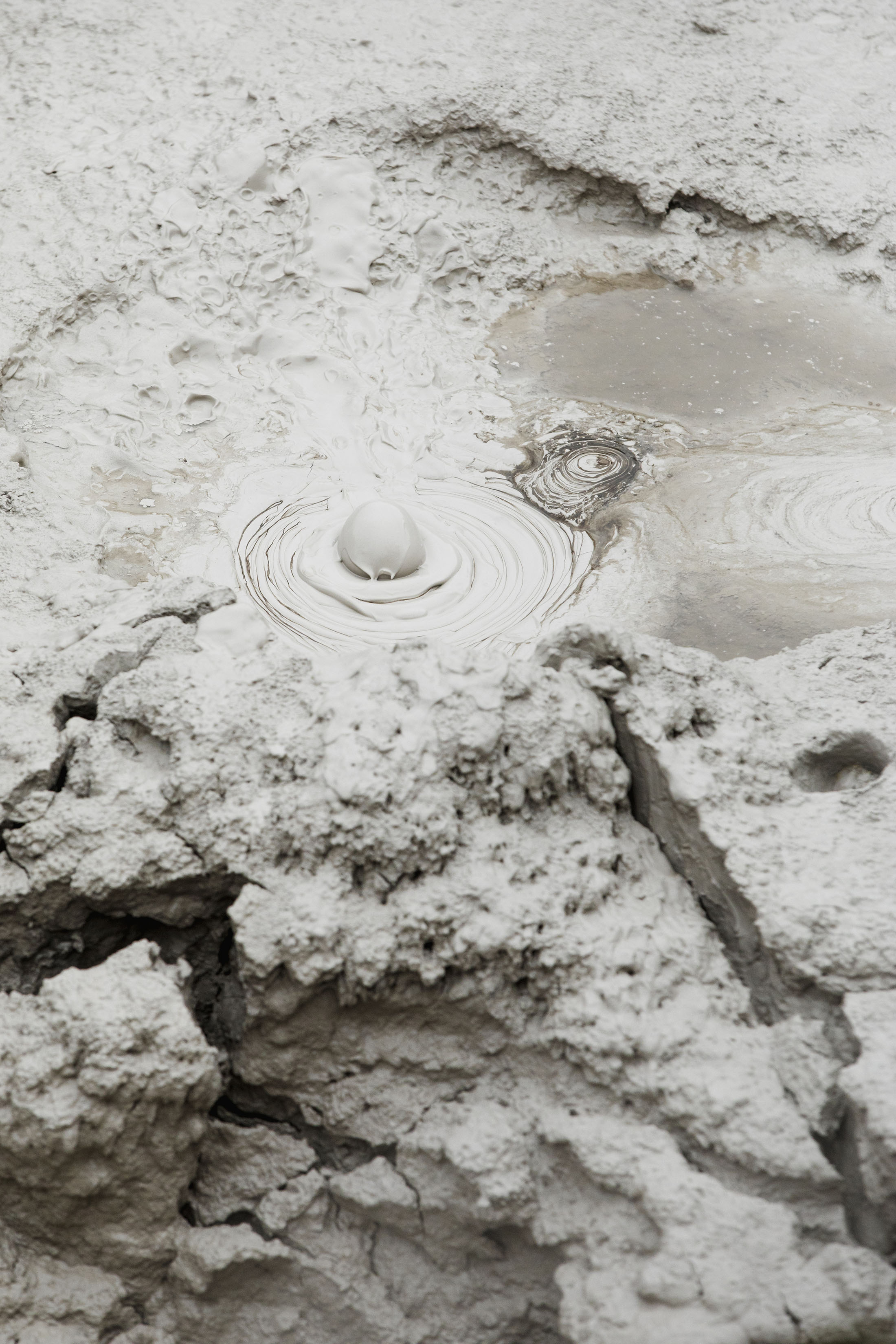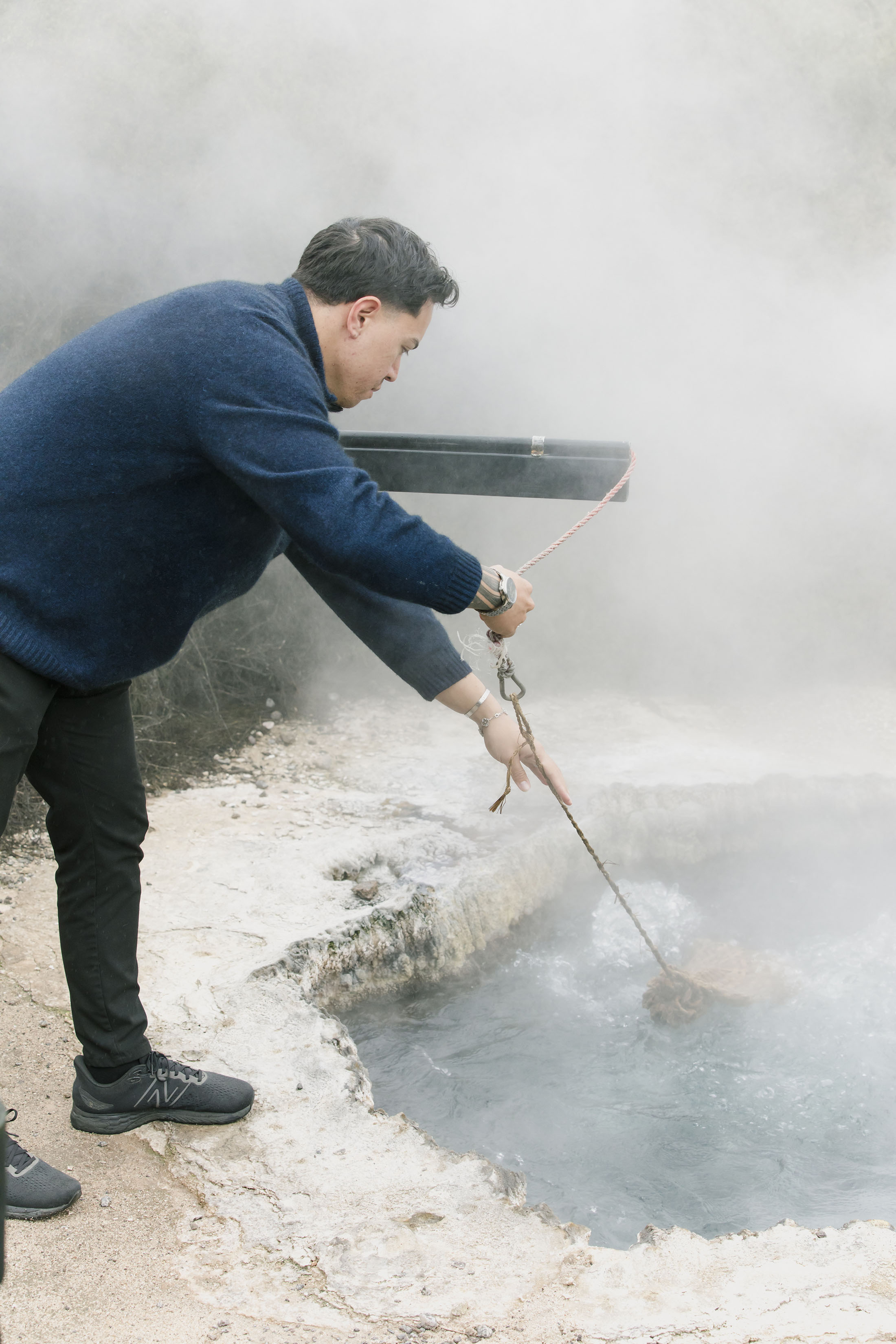Guided by Legacy
For the six generations of whānau at Te Puia, guiding is a responsibility. They’re kaitiaki of the whenua they grew up on.
For the six generations of whānau at Te Puia, guiding is a responsibility. They’re kaitiaki of the whenua they grew up on.
Steam curls through the cold morning air, rising from the geothermal valley in rhythmic bursts as if the land itself is breathing.
One by one, the geysers puff as if they’re performing a carefully rehearsed haka of steam and sound.
Mahanga first, then Kereru and Te Tohu will follow. Each burst and bubble a curtain raiser to the main event: Pōhutu. Poised at the viewing platform like a proud parent watching over her children, Te Puia general manager of visitor experience Denise Emery gives her visitors a countdown.
“Usually once Mahanga has made itself known, our guides know that Pōhutu is about 10 minutes away. It’s like clockwork.”
Sure enough, the largest geyser in the Southern Hemisphere introduces itself sending a burst of water and steam soaring skyward.

Denise smiles as if she knew it would happen. It’s almost as if she felt it. Not all geysers in the valley are predictable though. Some like Papakura, whom legendary guide Maggie Papakura takes her name from, laid dormant for 35 years before erupting again. Others, like Mahanga, have only just begun to bubble again.
“Every now and then she will blow, usually just before or after Pōhutu, and I get a little buzz,” Denise says. Growing up on the geothermal valley means some of the guides here at Te Puia have inherited knowledge that’s been passed through generations like a taonga.
Denise remembers swimming in the hot pools known as “The Blueys” as a child, when the tourists had gone and the gates were closed.
“We would run all through here. It never ceases to amaze me. There is nowhere like it anywhere else in the world.”
Navigating the rugged terrain in her black high-heeled boots, Denise walks the whenua the same way her great-grandmother, grandmother and mother did.
“We’re here to ensure that our whenua is handed over to the next generation in a much better position than we found it.”


Denise isn’t just working on the land she grew up on, she’s continuing a legacy. Her husband, son, daughter and grandson all work here too. The Tūhourangi Ngāti Wāhiao tribe have been welcoming visitors to this waiariki for more than 150 years.
After the 1886 eruption of Mount Tarawera, many of Denise’s ancestors relocated to Whakarewarewa running guided experiences through the whenua.
Denise is the fourth generation of her whānau to guide visitors through the 70 hectares of historic Te Whakarewarewa Geothermal Valley in Rotorua. “It’s in the blood,” she says. “I didn’t actually know that my great grandmother was a guide until I started working here.”
Denise is known as “Guide Timu” after her great grandmother.
At Te Puia, everyone knew the guides by one name. Guide Bella, Guide Maggie, Guide Bubbles. They’ve each become legends in their own right.
“Visitors would say, ‘Who did you have? I had Guide Bubbles’. They became quite famous guiding names.
“They were pioneers in self-employment, they were earning good money and they were doing it with pride and elegance,” says Denise.
“For them, it was all about sharing our stories, while also being well presented, eloquent, and punctual.”
No matter what was going on for them at home in what were challenging times in the world, as soon as the gates opened it was putting on their professional manner and focusing on manuhiri (visitors) first. “Always manuhiri first.”
In 1972 the Government decided to create a guiding certification programme through the New Zealand Māori Arts and Crafts Institute to help retain the tourism legacy of the likes of Guides Bella, Maggie and Rangi. Denise’s mother was one of the 10 wāhine selected for the programme, the first ever guides employed and paid by an organisation.
This is something Denise is currently working on bringing back in her own way with a Guiding Tohu Certification as she leads the next generation of guides on the same paths, with the same pride.
She explains that for the guides at Te Puia, it isn’t just a job, it’s a responsibility.
“We’re here to ensure that our whenua is handed over to the next generation in a much better position than we found it,” Denise says.
The idea is to give the 240,000 visitors each year a quality experience.
Leading a tour through the Tuku Iho Trail, which literally means to be “handed down”, Denise shares the stories of her rich whānau history.
The 2 hour and 45 minute premium experience takes visitors to hidden areas of the valley, allowing people to discover how her ancestors used the mineral-rich geothermal pools for centuries.
Stopping at a ngāwhā (hot pool), Denise’s son Patrick Emery demonstrates how to cook eggs in the boiling water. After eight minutes, he pulls the tkohu harakeke (flax) basket woven by students at the nearby Te Rito o Rotowhio (weaving) school from the bubbling hot pool.

“We have a responsibility to ensure that our legacy is passed on to our next generation and ensure we are representing our people and our legacy with the pride and mana that it deserves,” Denise says.
At the heart of Te Puia is the New Zealand Māori Arts and Crafts Institute (NZMACI), established on the Wakarewarewa site in 1963 but first formed by Sir Āpirana Ngata in 1926 to ensure traditional Māori arts would never be lost.
Today, the institute marks 60-plus years since the 1963 NZMACI Act was signed, making it an important time to reflect on its legacy and what lies ahead for the future.
The institute is also now iwi-owned through the 2020 Vesting Act, placing stewardship firmly in the hands of mana whenua under the Te Puia NZMACI Limited Partnership.
The partnership includes Wāhiao Tūhourangi o Whakarewarewa, Pukeroa Oruawhata Trust and Ngāti Hurungaterangi, Ngāti Taeotū and Ngāti Te Kahu o Ngāti Whakaue. The schools include Te Wānanga Whakairo Rākau (wood carving), Te Rito o Rotowhio (weaving) and Te Takapū o Rotowhio (stone and bone carving).
NZMACI is mandated to train Māori from iwi across Aotearoa and is open to a limited number of tauira (students) each year.
Behind these walls, students will dedicate two-to-three years crafting their legacies. From intricately woven cloaks to pounamu pendants, they learn traditional weaving and carving techniques under the guidance of master tutors who were once trainees at the school.
“It’s harder to get into than the All Blacks,” Denise says, as she watches over a student twisting a traditional tool made of wood and string to drill a hole into a piece of pounamu.
“We will spend hours over many days to drill this hole,” the student says. “It teaches us patience.”
Denise says there is so much history here.

“That’s what we’re passing on not only to the next generation, but to everyone from around the world who is interested in our culture.
“They come here thinking they’re going to see a geyser. By the time they leave here, they realise this is a family.
“This is a tribe who have looked after this land and have an obligation to ensure that it’s left in a better position than when they found it. “We are kaitiaki of this land.”
That is the legacy and the stories Denise’s son Patrick Emery is helping to share with the world.
For the 23-year-old marketing and communications co-ordinator, and fifth generation in the guiding lineage, working here is more than “just a job”.
Whether collaborating with international or national media, or crafting social content, Patrick is driven by the same passion that fuelled his ancestors.
“It’s a great privilege and a great pride of what I get to do in order to carry on that story, carry on the history.
“You don’t think of it so much as your nine-to-five kind of work. I just think of it as coming to see the family every day.”
He says visitors love hearing the story of Te Puia.
“Some of our visitors from Tahiti, or the islands come here on a journey of self discovery, or are trying to find that connection to the land,” he says.
“People are coming from all around the world to learn about our history and culture.
“It’s incredible to see the numbers that come through here each day, year after year, who just want to learn more about us. It’s pretty spectacular.”
Te Puia is more than a geothermal wonder, it’s a whānau.
Every story shared, every cloak woven or carving shaped, and every geyser that blows a whisper back to the land is a thread in the tapestry stretching back generations.
“If somebody were to ask me where do I see the place in 50 years? My answer is, much like it is now,” Denise says. “Not much would have changed. It will still be pristine, it will still be a beautiful place for people to visit.”


